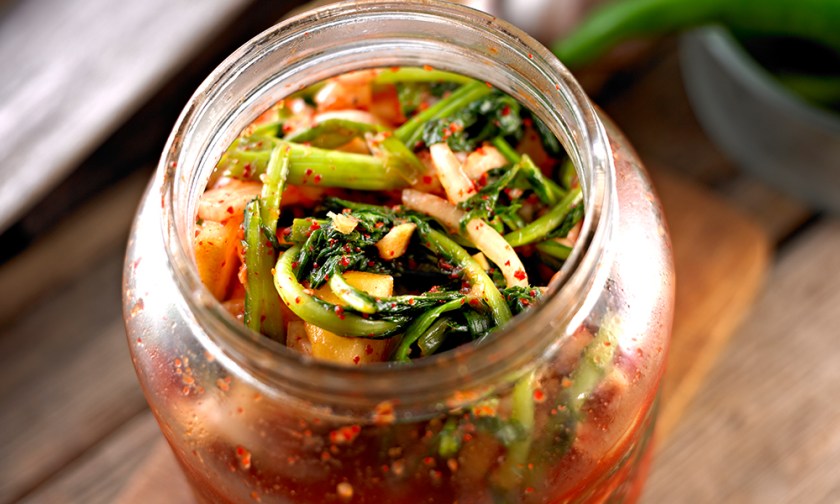If you attempted the infamous Cabbage Soup Diet back in the 1980s, you might dismiss the leafy green vegetable as plain and mundane, despite its nutritional value.
But if it is fermented – that is, soaked in salted water then stowed away, sealed in an airtight container for a few days – the humble cabbage becomes kimchi – tangy, flavourful and, many would argue, mouth-wateringly delicious!
Besides altering the taste, pickling or preserving food allows it to stay edible longer. It is therefore not surprising that the pickled delicacy remains Korea’s national dish since the 18th century – squirrelled away in jars during springtime to be brought out as a staple in the less fertile months.
For Koreans, it accompanies most meals. In fact, the majority of households cultivate their own special recipe – featuring variations of radish, onion, garlic and, of course, cabbage.
In the world of wellness, however, kimchi is championed more for its health benefits than taste – these pack a powerful, probiotic punch.
Probiotics are the “good” germs found in the digestive tract that supports our ability to absorb nutrients. They don’t survive long-term in our bodies, which is why we need them in our diet.
They are found in Greek yoghurt, sauerkraut and other types of fermented food. In fact, the fermentation process is responsible for unlocking the health benefits in certain foods, encouraging good bacteria to flourish.
“Our gut naturally and efficiently ferments everything we eat,” explains biochemist Mike Bridges, who we met at the launch of The Beauty Chef’s Glow Advanced Inner Beauty Powder when where he spoke about the relationship between good bacteria and gut health to a riveted audience.
“Only some strains of bacteria survive in our digestive tract, so fermenting food before we eat it (rather relying on our gut to do it for us) gives us access to a much wider range, supplying us with more probiotics, such as lactobacillus, which stimulates the immune system.
Lactobacillus is also renowned for aiding digestion and promoting cardiovascular health.
“Some bacteria can be harmful and even cause food poisoning if it grows during fermentation. This is the reason that lactic acid is essential in making pickled vegetables safe for eating.
Thankfully, we do not need to scour supermarket shelves for an elusive bottle of lactic acid to douse ingredients in, but, rather, it is produced naturally if the fermentation process is executed correctly.
“To be safe for consumption, the beneficial lactic acid bacteria needs to outgrow the harmful bacteria. This is why the salt concentration in the fermenting brine is so important and should be around 2 percent.
“Using a completely air lock jar is also essential, as it prevents mould and provides a perfect environment for lactic acid to flourish.”
Mike shares his method for making probiotic pickled vegetables (aka kimchi) with SPA+CLINIC.
Equipment
5 L fermenting jar with airlock
Food scales – using food scales to weigh salt and other ingredients ensures accuracy and safety.
Ingredients
Vegetables:
1 x wombok (Chinese cabbage)
3 x spring onions
1 x daikon
4 x cloves garlic
Soaking Brine:
500 mL water
60 g salt
Fermenting Brine:
500 mL water
25 g raw sugar
4.5 g salt
100 mL fish sauce (contains 7.5g salt per 100 mL)
15 g glutinous rice flour
50 g gochugaru (Korean chilli powder)
Process
Brining the cabbage – the aim of this step is to wilt the cabbage so it will pack well in the fermentation jar.
- Peel the outer leaves off the cabbage and discard. Remove the stems and finely slice the leaves. Add to a large bowl.
- Make the soaking brine by dissolving the salt in the water.
- Place the dice cabbage in a bowl, pour over the soaking brine until the cabbage is covered. Leave overnight
Fermentation brine – the aim of this step is to kill the bacteria in these ingredients and also to allow the glutinous rice flour to thicken the brine.
- Add all ingredients to a sauce pan and gradually bring to the boil.
- Remove from heat and allow to cool.
- Place in the refrigerator overnight. It’s fine to allow the brine to cool to around 60C before placing in the fridge, although it can also be placed in the fridge while hot. The aim is to cool quickly by placing in the fridge to minimise the growth of spore forming (bad) bacteria.
Fermentation (next morning)
- Pour out the soaking brine then cover the cabbage again with fresh water. Mix gently and allow to stand for 2 mins. Pour out the water and allow to drain.
- Finely slice and add the remaining vegetables.
- Mix the vegetables and add to the fermentation jar. Press down lightly to compact.
- Pour in the fermentation brine until the vegetables are covered. Not all the brine needs to be added, just enough to ensure the vegetables are submerged.
- Seal with the lid and airlock and store in a cool, dark place for around 3 days. During this time you will notice the air-lock bubbling. When the bubbling stops, the fermentation is complete.
- Store in the fridge and consume within four weeks.
- Kimchi should have a distinct sour taste which is from the lactic acid produced by the fermentation. The lactic acid is critical to ensure no harmful bacteria are able to grow. If the sour taste is not present, do not consume.
*Dr Mike Bridges has a degree in chemical engineering and a PhD in biotechnology. Most of his time is spent running large food manufacturing companies, but his passion is fitness, health and beauty. He has worked with many different types of fermented products and understands the technical aspects of fermentation as well as the health benefits.




